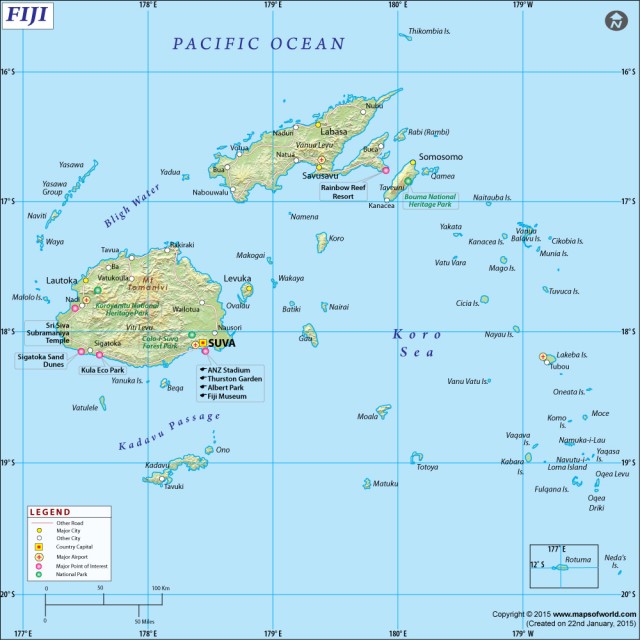Fiji
Area 6,767 square mi (18,270 square km)
Population 887,000 2014
Capital Suva
Highest Point Tomanivi 4,343 ft (1,324 m)
Lowest Point 0 m
GDP $4.030 billion 2014
Primary Natural Resources timber, fish, gold, copper, offshore oil.
THE REPUBLIC OF the Fiji Islands, a part of Oceania, is an archipelago in the South PACIFIC OCEAN, about one-third of the way from NEW ZEALAND to HAWAII. The island group consists of 332 islands (110 inhabited) and has a combined area somewhat smaller than NEW JERSEY. The islands consist mainly of volcanic hills and mountains that are lush in tropical vegetation. The climate is tropical maritime and is characterized by adominance of warm, moist air masses, high levels of precipitation, cyclonic storms (November through January), and minimal seasonal temperature fluctuation.

Fiji has a high birth rate (23/1000 in 2003), a low death rate (5.7/1000 in 2003), a rapid rate of natural increase (1.7 percent), and a notable out-migration. Population density is moderate, life expectancy is fairly high (68.9 years), and the median age, only 23.7 years, is markedly lower than for North America. The majority ethnic group, Fijian (51 percent), is mainly Melanesian with a strong Polynesian influence. Minority groups include Indians (44 percent), who are mostly Hindu, Europeans, and other Pacific Islanders. Christianity is the primary religion among the Fijians and in the island group as a whole (52 percent), especially Methodism and Catholicism, followed by Hinduism (38 percent) and Islam (8 percent). English, the official language, is accompanied by Fijian and Hindustani. Education is free for young people ages 6 to 14, and national literacy is above 90 percent.
Fiji has a well-developed economy based largely on sugar exports, tourism, clothing, copra, gold, silver, lumber, and small cottage industries. Being insular, Fiji has a long total coastline and adheres to international guidelines for the division of ocean waters. It claims a 12 nautical mi territorial sea and a 200 nautical mi Exclusive Economic Zone for resource development. Given its rugged terrain, only 10.9 percent of this island country is arable. Agriculture employs 17 percent of the official workforce and produces a range of commodities from sugar, cassava (tapioca), rice, and coconuts to sweet potatoes, bananas, pigs, and cattle. With this production, Fiji faces serious ecological issues such as deforestation, soil erosion, chemical contamination, and siltation of internal waters.
Fiji received its independence from the United Kingdom on October 10, 1970, amended its constitution in July 1998 to include national open voting, and today has an elected government. Poverty, subsistence living, political polarization between Fijians and Indians, and national fiscal management remain serious challenges. The country's executive branch consists of a chief of state or president and a head of government or prime minister. The parliament comprises a senate and house of representatives, and the supreme court oversees a legal system borrowed from the British. The country is divided administratively into four divisions, the northern, eastern, western, and central, and one dependency, Rotuma.